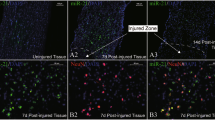Abstract
To assess the therapeutic effects of microRNA-21 (miR-21) knockdown (KD) for acute thoracic spinal cord contusion using a mouse model. Forty C57/BL6 mice were randomly divided into four groups: mice in the sham-operated (Sham) group received surgical procedure without spinal cord contusion; the spinal cord injury (SCI) group mice underwent spinal cord contusion without treatment; mice in the miR-21 KD group underwent spinal cord contusion followed by a single dose subdural injection of miR-21 KD vectors (1 × 107 TU); and the negative control (NC) group mice were given subdural injection of comparable amount of NC vectors (1 × 107 TU) after spinal cord contusion. The Basso Mouse Scale (BMS) was employed to assess hindlimb motor functions. Hematoxylin–eosin and Luxol fast blue staining were performed to evaluate pathologic changes in spinal cord tissues. Peripheral blood serum levels of tumor necrosis factor α (TNFα), transforming growth factor β (TGF-β) and interleukin-1β (IL-1β) were determined by the enzyme-linked immunosorbent assay, and mRNA expression of Brain derived neurotrophic factor (BDNF) was examined by reverse transcription-polymerase chain reaction (RT-PCR). Western blotting was performed to analyze the AKT signaling pathway. KD of miRNA-21 effectively improved the BMS scores at day 14 post-surgery compared with the SCI group (p < 0.01). The spinal cord tissue in the miR-21 KD group displayed the most overt histologic signs of recovery, with axonal regeneration and the recovery of neuronal morphology at day 14 post-surgery. Significantly alleviation of TGF-β1, TNF-α and IL-1β was also found in sera from the miR-21 inhibition group in comparison to others, whereas BDNF gene expression was upregulated following miR-21 KD (p < 0.01). Further, significantly decreased AKT phosphorylation activity was illustrated in the miR-21 KD group (p < 0.001). The data suggest that miR-21 KD significantly reduces the inflammatory response at the damaged spinal cord site and promotes motor functional recovery. The treatment also elevated expression of BDNF, a neurotrophin participating in nerve regeneration.







Similar content being viewed by others
References
Sharif-Alhoseini M, Rahimi-Movaghar V (2014) Animal models in traumatic spinal cord injury. Top Paraplegia. https://doi.org/10.5772/57189
Fitch MT, Silver J (2008) CNS injury, glial scars, and inflammation: inhibitory extracellular matrices and regeneration failure. Exp Neurol 209(2):294–301
Kawano H et al (2012) Role of the lesion scar in the response to damage and repair of the central nervous system. Cell Tissue Res 349(1):169–180
Karimi-Abdolrezaee S, Billakanti R (2012) Reactive astrogliosis after spinal cord injury-beneficial and detrimental effects. Mol Neurobiol 46(2):251–264
Shearer MC, Fawcett JW (2001) The astrocyte/meningeal cell interface—a barrier to successful nerve regeneration? Cell Tissue Res 305(2):267–273
Nieto-Diaz M et al (2014) MicroRNA dysregulation in spinal cord injury: causes, consequences and therapeutics. Front Cell Neurosci 8:53
Liu G et al (2010) miR-21 mediates fibrogenic activation of pulmonary fibroblasts and lung fibrosis. J Exp Med 207(8):1589–1597
Shen W et al (2014) MicroRNA-21/PTEN/Akt axis in the fibrogenesis of biliary atresia. J Pediatr Surg 49(12):1738–1741
Thum T et al (2008) MicroRNA-21 contributes to myocardial disease by stimulating MAP kinase signalling in fibroblasts. Nature 456(7224):980–984
Wei J et al (2013) MicroRNA-21 activates hepatic stellate cells via PTEN/Akt signaling. Biomed Pharmacother 67(5):387–392
Zarjou A et al (2011) Identification of a microRNA signature in renal fibrosis: role of miR-21. Am J Physiol 301(4):F793–F801
Ning B et al (2014) microRNAs in spinal cord injury: potential roles and therapeutic implications. Int J Biol Sci 10(9):997–1006
Cao XJ et al (2015) Repair, protection and regeneration of spinal cord injury. Neural Regen Res 10(12):1953–1975
Liu NK et al (2009) Altered microRNA expression following traumatic spinal cord injury. Exp Neurol 219(2):424–429
Basso DM et al (2006) Basso Mouse Scale for locomotion detects differences in recovery after spinal cord injury in five common mouse strains. J Neurotrauma 23(5):635–659
Garcia E et al (2016) Cytokine and growth factor activation in vivo and in vitro after spinal cord injury. Mediators Inflamm. https://doi.org/10.1155/2016/9476020
Fernandez-Klett F, Priller J (2014) The fibrotic scar in neurological disorders. Brain Pathol 24(4):404–413
Zhu Y et al (2015) Fibronectin matrix assembly after spinal cord injury. J Neurotrauma 32(15):1158–1167
Zhu Y et al (2015) Hematogenous macrophage depletion reduces the fibrotic scar and increases axonal growth after spinal cord injury. Neurobiol Dis 74:114–125
Krichevsky AM, Gabriely G (2009) miR-21: a small multi-faceted RNA. J Cell Mol Med 13(1):39–53
Bhalala OG et al (2012) microRNA-21 regulates astrocytic response following spinal cord injury. J Neurosci 32(50):17935–17947
Chi LY et al (2008) The dual role of tumor necrosis factor-alpha in the pathophysiology of spinal cord injury. Neurosci Lett 438(2):174–179
Pineau I, Lacroix S (2007) Proinflammatory cytokine synthesis in the injured mouse spinal cord: multiphasic expression pattern and identification of the cell types involved. J Comp Neurol 500(2):267–285
Acknowledgements
The authors wish to thank Dr. Guo-Dong Tang for his expertise and technical assistance. This work is supported by the National Natural Science Funds of China (Nos. 81401014, 81771346), the Chinese Postdoctoral Science Foundation (No. 2014M561935), the Natural Science Funds of Shandong Province (No. ZR2016HP41), the Chinese Postdoctoral Science Foundation (No. 2015T80725), and the Technology Research and Development Program of Jinan City (No. 201704133).
Author information
Authors and Affiliations
Corresponding author
Ethics declarations
Conflict of interest
The authors declare that they have no conflict of interest.
Rights and permissions
About this article
Cite this article
Xie, W., Yang, Sy., Zhang, Q. et al. Knockdown of MicroRNA-21 Promotes Neurological Recovery After Acute Spinal Cord Injury. Neurochem Res 43, 1641–1649 (2018). https://doi.org/10.1007/s11064-018-2580-1
Received:
Revised:
Accepted:
Published:
Issue Date:
DOI: https://doi.org/10.1007/s11064-018-2580-1




